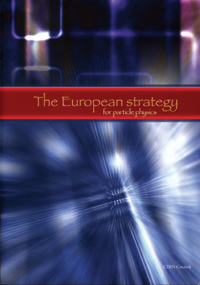The European strategy for particle physics
Recommendations approved by CERN Council establish policy
for Europe to “maintain and strengthen its central position.”
By Judy Jackson
 |
|
Photo: Tim O'Hara |
At a special meeting in Lisbon on July 14, the CERN Council unanimously adopted a 17-point European Strategy for Particle Physics, based on the premise that "Europe should maintain and strengthen its central position in particle physics."
In its vote, the Council adopted a set of draft recommendations prepared by the CERN Council Strategy Group, a 36-member committee created and charged by the CERN Council in June 2005. The statement, signed by all CERN member states, now has the force of a resolution establishing the policy for the European future of the field.
In that respect, the European statement differs from a US report, Revealing the Hidden Nature of Space and Time: Charting the Course for Elementary Particle Physics, issued earlier this year by the EPP2010 committee headed by economist Harold Shapiro. The EPP2010 document made recommendations to policy makers, while the CERN statement commits the governments of CERN Council member states: it IS policy.
Members of the Strategy Group stress the distinction, sometimes difficult for non-Europeans to grasp, between CERN the Council and CERN the laboratory. The former has responsibility for coordinating all major activities in particle physics in Europe, including but not limited to the management of CERN the laboratory. It is the CERN Council that initiated the strategic planning process and adopted the strategy statement.
 |
|
The CERN Council's European strategy for particle physics is available online. Image courtesy of CERN Council |
Each of the 20 CERN Council member states has two official delegates. According to the Council's Web site, one represents "his or her government's administration and the other national scientific interests. Each Member State has a single vote and most decisions require a simple majority, although in practice the Council aims for a consensus as close as possible to unanimity."
The Strategy Group, chaired by physicists Ken Peach of Oxford University and Torsten Åkesson of Lund University, was born of the necessity for coordinated strategic planning at a time when the Large Hadron Collider at CERN is about to begin operations; and when other projects, including the proposed International Linear Collider, are under consideration. The European Strategy defines how Europe will address these and other programs and initiatives.
"We need to secure European leadership in particle physics," said CERN Council president Enzo Iarocci at a press briefing after the Lisbon meeting. "This means not thinking in terms of labs and universities, but aiming for global coordination and collaboration."
As part of the planning process, the Strategy Group held an open forum at the Laboratoire de l'Accélerateur Linéaire at Orsay, near Paris, in January 2006, to hear from all interested members of the European particle physics community. In May, they met again at DESY Zeuthen, near Berlin, to draft the recommendations that would be presented to the Council for adoption.
In another difference from the EPP2010 process in the United States, which included European and Japanese committee members, the European Strategy Group included only Europeans. This all-European membership was dictated by the difference in the process from the American analog, explained a member of the committee. Rather than presenting their particular professional or scientific points of view, members represented the governments of their member states, whose commitment would be required in order for the draft statement to become policy. "It's not who wrote it that's important," a participant explained. "It's who signed it."
However, the European process included international participation. In response to formal invitations from the Strategy Group, members of the international particle physics community, including directors of the world's particle physics laboratories, provided their views and perspectives, and international representatives contributed to working groups during the Zeuthen "drafting" meeting.
Despite differences in the European and US processes, Fermilab director Pier Oddone noted the synergy between the two sets of recommendations in a talk at an International Linear Collider Workshop in Vancouver, Canada in August.
"There is a remarkable degree of coherence," Oddone said, "which tells us that the communities across the world agree on the future tasks of particle physics."
A press release issued by the Council put the European strategy in a global context: "The Council took the initiative to launch the strategy process...recognising that the LHC is a unique facility for the world's particle physicists, and considering that this was the right time to address the issue of how European particle physics will engage with other regions of the world to develop the next generation of particle physics facilities."
|
General issues 2. Increased globalization, concentration and scale of particle physics make a well coordinated strategy in Europe paramount; this strategy will be defined and updated by CERN Council as outlined below. Scientific activities 4. In order to be in the position to push the energy and luminosity frontier even further it is vital to strengthen the advanced accelerator R&D programme; a coordinated programme should be intensified, to develop the CLIC technology and high performance magnets for future accelerators, and to play a significant role in the study and development of a high-intensity neutrino facility. 5. It is fundamental to complement the results of the LHC with measurements at a linear collider. In the energy range of 0.5 to 1 TeV, the ILC, based on superconducting technology, will provide a unique scientific opportunity at the precision frontier; there should be a strong well-coordinated European activity, including CERN, through the Global Design Effort, for its design and technical preparation towards the construction decision, to be ready for a new assessment by Council around 2010. 6. Studies of the scientific case for future neutrino facilities and the R&D into associated technologies are required to be in a position to define the optimal neutrino programme based on the information available in around 2012; Council will play an active role in promoting a coordinated European participation in a global neutrino programme. 7. A range of very important non-accelerator experiments take place at the overlap between particle and astroparticle physics exploring otherwise inaccessible phenomena; Council will seek to work with ApPEC to develop a coordinated strategy in these areas of mutual interest. 8. Flavour physics and precision measurements at the high-luminosity frontier at lower energies complement our understanding of particle physics and allow for a more accurate interpretation of the results at the high-energy frontier; these should be led by national or regional collaborations, and the participation of European laboratories and institutes should be promoted. 9. A variety of important research lines are at the interface between particle and nuclear physics requiring dedicated experiments; Council will seek to work with NuPECC in areas of mutual interest, and maintain the capability to perform fixed target experiments at CERN. 10. European theoretical physics has played a crucial role in shaping and consolidating the Standard Model and in formulating possible scenarios for future discoveries. Strong theoretical research and close collaboration with experimentalists are essential to the advancement of particle physics and to take full advantage of experimental progress; the forthcoming LHC results will open new opportunities for theoretical developments, and create new needs for theoretical calculations, which should be widely supported. Organizational issues 12. Future major facilities in Europe and elsewhere require collaborations on a global scale; Council, drawing on the European experience in the successful construction and operation of large-scale facilities, will prepare a framework for Europe to engage with the other regions of the world with the goal of optimizing the particle physics output through the best shared use of resources while maintaining European capabilities. 13. Through its programmes, the European Union establishes in a broad sense the European Research Area with European particle physics having its own established structures and organizations; there is a need to strengthen this relationship for communicating issues related to the strategy. 14. Particle physicists in the non-Member States benefit from, and add to, the research programme funded by the CERN Member States; Council will establish how the non-Member States should be involved in defining the strategy. Complementary issues 16. Technology developed for nuclear and particle physics research has made and is making a lasting impact on society in areas such as material sciences and biology (e.g. synchrotron radiation facilities), communication and information technology (e.g. the web and grid computing), health (e.g. the PET scanner and hadron therapy facilities); to further promote the impact of the spin-offs of particle physics research, the relevant technology transfer representatives at CERN and in Member states should create a technology transfer forum to analyse the keys to the success in technology transfer projects in general, make proposals for improving its effectiveness, promoting knowledge transfer through mobility of scientists and engineers between industry and research. 17. The technical advances necessary for particle physics both benefit from, and stimulate, the technological competences available in European industry; Council will consolidate and reinforce this connection, by ensuring that future engagement with industry takes account of current best practices, and continuously profits from the accumulated experience. Source: The European strategy for particle physics, CERN Council, 2006. |
Click here to download the pdf version of this article.






